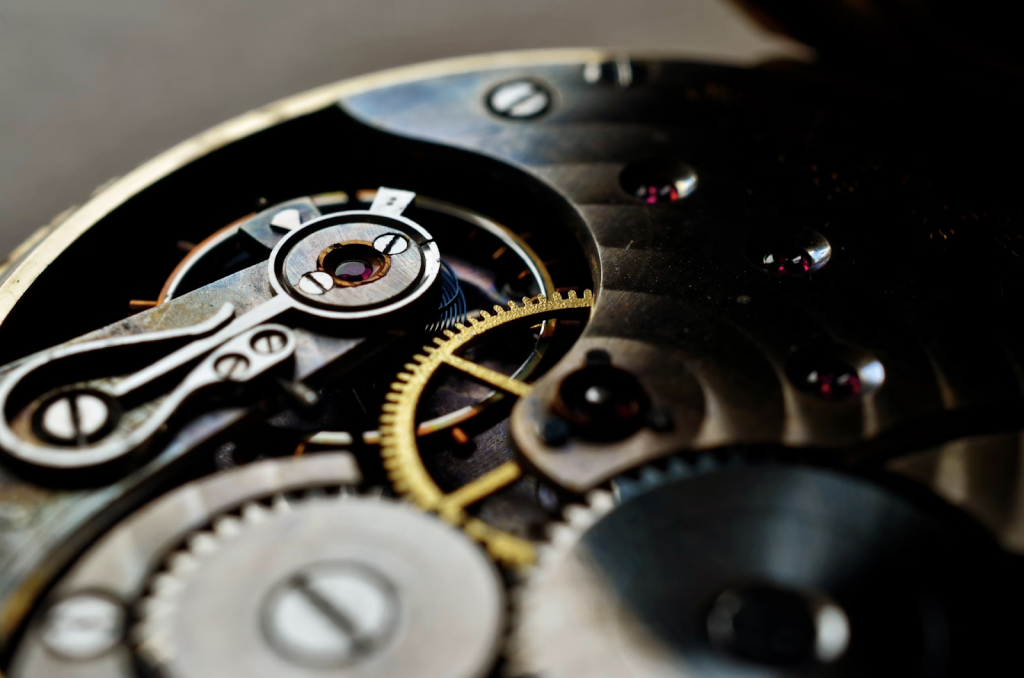
Before googling watch repairs near me, have a look at this to make sure you are not being ripped off. Watch making has been around for generations. Careers have been built to make and repair these timeless classics and it takes a very keen eye to even see which part is damaged or which part needs replacing. In this article we explore the different watch parts that tend to break the most.
1. The Power Within: The Movement
The movement, often referred to as the heart of the watch, is a complex mechanism that drives the hands of the watch. It can be mechanical (manual or automatic) or quartz. Each type has its vulnerabilities:
- Mechanical Movements: These rely on a series of gears, springs, and levers. The mainspring, which powers the watch, can become over-wound or break. The escapement, which regulates the time, can wear down due to friction. Regular lubrication and servicing are crucial to maintaining the accuracy of mechanical movements.
- Quartz Movements: These use a battery to power a quartz crystal oscillator. The battery typically needs replacement every 1-2 years. Additionally, quartz movements can suffer from electronic component failures, which might necessitate professional repairs.
2. The Watch’s Armor: The Case and Crystal
The case and crystal protect the delicate movement inside. However, they are not invincible:
- Scratched Crystal: Crystals, whether made of mineral glass or sapphire crystal, are susceptible to scratches from everyday wear and tear. While minor scratches might not be a major concern, deeper scratches can affect readability. Mineral glass crystals can be polished to remove light scratches, but deeper scratches or cracks usually necessitate replacement. Sapphire crystals are much more scratch-resistant, but they can still crack upon significant impact.
- Dented or Corroded Case: The case, typically made of metal or plastic, can become dented or scratched due to impacts. In some cases, the case may also corrode, especially if it’s not water-resistant. Depending on the material and severity of the damage, the case may need buffing, polishing, or even replacement.
3. Through the Looking Glass: The Crystal
The crystal is the clear covering that protects the dial of the watch. It can be made of acrylic, mineral glass, or sapphire crystal:
- Acrylic Crystals: These are the most prone to scratches but can often be polished to remove minor blemishes. However, they are more likely to crack or break upon impact.
- Mineral Glass: More scratch-resistant than acrylic, but still susceptible to scratches and shattering if struck forcefully.
- Sapphire Crystal: The most scratch-resistant, but also the most likely to shatter or chip upon severe impact. Replacing a sapphire crystal can be costly.
4. The Watch’s Seal: The Crown and Gaskets
The crown is the knob used to adjust the time and date. It also plays a crucial role in maintaining the watch’s water resistance. Here’s what can go wrong:
- Worn Gaskets: Gaskets are small rubber seals that create a watertight barrier between the case, crown, and caseback. Over time, these gaskets can wear out and lose their effectiveness. This can allow moisture to seep into the watch, potentially damaging the movement and dial. Replacing the gaskets is a crucial part of routine watch maintenance.
- Faulty Crown: The crown mechanism can malfunction, making it difficult to wind the watch or adjust the time. This can be due to worn components or debris lodged within the mechanism. Repairs may involve cleaning the crown or replacing components.
5. The Hands
The hands of a watch can become misaligned, bent, or even fall off. This can be caused by shock, magnetic fields, or wear and tear. Misaligned hands can affect the accuracy and readability of the watch, requiring realignment or replacement.
Conclusion
Taking care of your watch is like taking care of your most prized possessions. It has many different parts that can become faulty any time so taking precautions and proper maintenance is always key to products such as these. By taking your time to learn the watches’ different important parts, a budding collector such as yourself can worry a little bit less about your wristwatch’s longevity.

